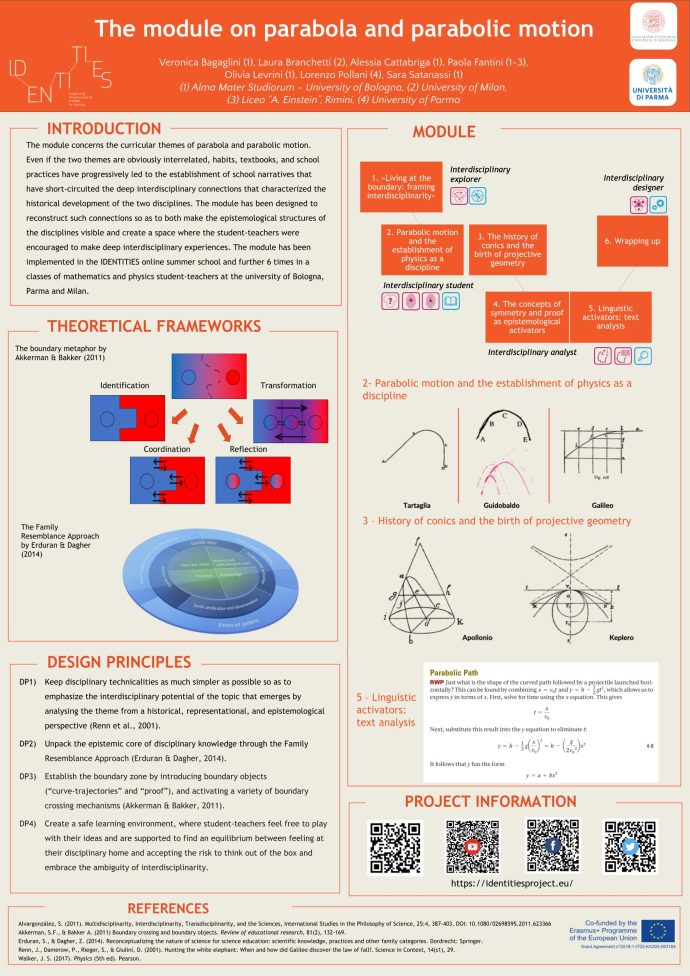Download the module’s lesson plan (pdf, editable format)
The module concerns the curricular themes of parabola and parabolic motion. The themes have been chosen since, even if they are obviously interrelated, habits, textbooks, and school practices have progressively led to the establishment of school narratives that have short-circuited the deep interdisciplinary connections that characterized the historical development of the two disciplines. The historical episodes are reconstructed as two emblematic cases to highlight the structural role of mathematics in physics and vice versa. The module has been designed to emphasize the connections so as to both make the epistemological structures of the disciplines visible and create a space where the student-teachers were encouraged to make deep interdisciplinary experiences.
The IDENTITIES approach for the design and implementation of the module is mainly evident in the choice of the following design principles:
- Keep disciplinary technicalities as much simpler as possible so as to emphasize the interdisciplinary potential of the topic that emerges by analysing the theme from a historical, representational, and epistemological perspective (Renn et al., 2001)
- Unpack the epistemic core of disciplinary knowledge through the Family Resemblance Approach (Erduran & Dagher, 2014)
- Establish the boundary zone by introducing boundary objects (“curve-trajectories” and “proof”), and activating a variety of boundary-crossing mechanisms (Akkerman & Bakker, 2011)
- Create a safe learning environment, where student-teachers feel free to play with their ideas and are supported to find an equilibrium and inhabit the tension between feeling at their disciplinary home and accepting the risk of thinking out of the box and embracing the ambiguity of interdisciplinarity.
 Becoming explorers
Becoming explorers
Aims: The first submodule aims to introduce the tools to analyse the disciplines’ identities and their integration. To this scope, the Family Resemblance Approach and the metaphor of the “boundary” are introduced. A further aim is to share their ideas on the knowledge that representations of curves embed and the criteria that can be used to establish if they are parabolas.
Activities: Three team-work activities are implemented. The first one guides the students to get acquainted with the vocabulary of Akkerman and Bakker by sharing personal experiences of crossing boundaries and eventual difficulties they have met. The second one invites the students to reflect on aims & values of their disciplines, practices, methods, and forms of knowledge by sharing and commenting on examples of such epistemological elements. In the third activity, the student-teachers are invited, in group, to analyse a set of images that represents curves and point out criteria that can be used to establish if and why a curve can be recognised as a parabola.
Introduction to the module
Ice-breaking and boundary activities (pdf, editable format)

Introduction to the IDENTITIES project: disciplines, interdisciplinarity, and key questions (pdf, editable format)

Curricular and S-T-E-M advanced interdisciplinarity (video)

Images of interdisciplinarity (pdf, editable format)


Taxonomy of interdisciplinarity (video)

Curves and trajectories
Parabola images and discussion (pdf, editable format)





Production of a home report about the group’s discussion





Lenses to look at interdisciplinarity
Introduction to the boundary metaphor (pdf, editable format)


Introduction to boundary objects and boundary-crossing mechanisms (video)

Brainstorming on “What do you mean by science?”

Introduction to the Family Resemblance Approach (FRA) to reflect on disciplinary identities and their comparison (pdf, editable format)

NOS and FRA wheel survey (pdf, editable format)

 Becoming students
Becoming students
Aims: The second submodule aims to unpack the interdisciplinary potential of the topic of parabola and parabolic motion, by analysing the theme from a historical, representational, and epistemological perspective. The analysis is carried out to show the co-evolution of the two disciplines and, specifically, to unveil boundary objects and boundary-crossing mechanisms that had a foundational role in the establishment or re-definition of the identities of physics and mathematics as disciplines.
Activities: Through interactive lectures, the student-teachers, in the role of “students”, are guided to experience two parallel narratives: the “physics” narrative where the structural role of mathematics is emphasised in the discovery of parabolic shape of projectile motion and the establishment of physics as discipline; the “mathematics” narrative, where the structural role of physics was stressed in the historical evolution that led to the re-classification of conics in mathematics. In the middle, the student-teachers are involved in an activity focused on reflecting on the construct of proof in mathematics and in physics.
Conics and motions in the history of Mathematics and Physics
Parabolic motion and the birth of Physics as a discipline: Aristotle, Tartaglia, Guidobaldo, Galileo (pdf, editable format)





Epistemological differences between parabola images (pdf, editable format)



Parabola as a conic section. A historical dialogue between mathematics and physics: Euclid, Apollonio, Archimede, Witelo, Kepler (pdf, editable format)



 Becoming analysts
Becoming analysts
Aims: The third submodule has two main related aims: 1) giving the participants the fundamental linguistic notion of the scientific language, the linguistic and the epistemological tools allowing them to analyse scientific texts; 2) recognising the elements of disciplinary’s identities, boundary objects and boundary crossing mechanisms as they are represented in scientific texts (both historical texts and textbooks).
Activities: To the participants, epistemological and linguistic grids are provided as a summary or enrichment of the second submodule. Through this activity, they are guided to apply the disciplinary and interdisciplinary knowledge and tools they have learned as lenses to break down stereotypes and unpack how textbooks convey specific images of mathematics and physics and of their possible relationships.
Argumentation and proof at the boundary between Mathematics and Physics
Make a proof of Pythagora’s theorem (pdf, editable format)


Proof in mathematics and the Galileo’s proof analysis (pdf, editable format)



Text analysis
Linguistic tool for Physics textbook analysis (pdf, editable format)



Textbook linguistic analysis: ad hoc questions grid (pdf, editable format)



Linguistic analysis of textbooks (Physics, volume 1, by James S. Walker, 2017) (pdf, editable format)



Habermas’ rationality introduced as scaffolding to analyse a text (pdf, editable format)


Walker’s Habermas analysis: guiding questions (pdf, editable format)


Epistemological analysis of textbooks (Physics, volume 1, by James S. Walker, 2017) (pdf, editable format)


Wrap-up activities
Discussion on the comparison between Galileo and Walker

Discussion on novel elements of activators (e.g. curves and proofs)



Production of a final report (pdf, editable format)

Download the module’s lesson plan (pdf, editable format)

